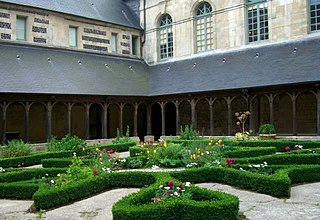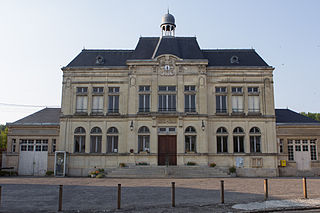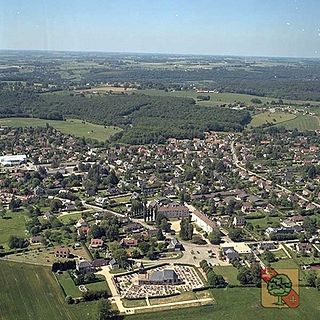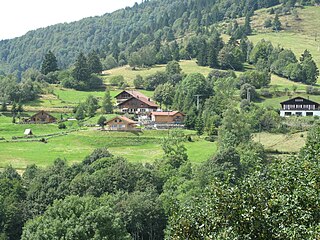
Harcourt is a commune in the Eure department in the Normandy region in northern France.

Montivilliers is a commune in the Seine-Maritime department in the Normandy region in northern France.

Dompierre-les-Ormes is a commune in the department of Saône-et-Loire in Bourgogne-Franche-Comté, France.

Cardeilhac is a commune in the Haute-Garonne department in southwestern France.

Saint-Sulpice-de-Favières is a commune in the Essonne department in Île-de-France in northern France, located in the metropolitan area of Paris.

The elm cultivar Ulmus 'Hillieri' arose from a chance seedling at Hillier's Pitt Corner nursery near Winchester, England, in 1918, and was marketed from 1928 as Ulmus hillieri, a name accepted by Christine Buisman in her 1931 labelling of a specimen in France. Since at least 1944 the tree has been determined a form of Ulmus × hollandica, its designation at Kew Gardens, in Green, and in later Hillier catalogues. In 1940, 'Hillieri' was noted as being a hybrid of uncertain origin. Krüssmann notes that for a time the tree was listed by Hilliers as U. × hillieri.
The elm cultivar Ulmus 'Monstrosa' is believed to have originated in France, where it was listed without description as a form of Field Elm, Ulmus campestris var. monstrosa. Krüssman included it in his manual as an Ulmus glabra cultivar, but the plant's long, slender 2 cm petiole is not a feature of U. glabra, and is even less likely in a shrub form of this tree.
The Wych Elm cultivar Ulmus glabra 'Dovaei' was raised by the André Leroy nursery at Angers, France, as Ulmus dovaei before 1868.
The elm cultivar Ulmus 'Rugosa' [:'wrinkled', the leaves], was first listed in Audibert's Tonelle (1817), as "U. campestris Linn. 'Rugosa' = orme d'Avignon ", but without description. Green identified this cultivar with one listed by Hartwig and Rümpler in Illustrirtes Gehölzbuch (1875) as Ulmus montana var. rugosaHort.. A cultivar of the same name appeared in Loddiges' catalogue of 1836 and was identified by Loudon in Arboretum et Fruticetum Britannicum (1838) as Ulmus montana var. rugosaMasters; Masters accorded the tree the common name of maple-bark elm. Ulmus montana was used both for wych cultivars and for hybrid cultivars of the Ulmus × hollandica group.
The Field Elm cultivar Ulmus minor 'Albo-Dentata' first featured in the Baudriller nursery catalogue of 1880 as U. microphylla foliis albo-dentata. It was distributed by the Späth nursery of Berlin in the late 19th and early 20th century, as U. campestris microphylla fol. albo-dentatis.

Tigny-Noyelle is a commune in the Pas-de-Calais department in the Hauts-de-France region of France.

La Mure is a commune in the Isère département in southeastern France.

Craonne is a commune in the Aisne department in Hauts-de-France in northern France.

Hennezel is a commune in the Vosges department in Grand Est in northeastern France.

Houppeville is a commune in the Seine-Maritime department in the Normandy region in northern France.
The field elm cultivar 'Punctata' [:'spotted', the leaf] first appeared in the 1886–87 catalogue of Simon-Louis of Metz, France, as U. campestris punctata. It was distributed by the Späth nursery, Berlin, in the 1890s and early 1900s as U. campestris punctataSim.-Louis, the Späth catalogue listing it separately from U. campestris fol. argenteo-variegata and from U. campestris fol. argenteo-marginata. Green considered it possibly a synonym of the Field Elm cultivar 'Argenteo-Variegata'.
The Communauté d'agglomération d'Épinal is an administrative association of communes in the Vosges department of eastern France. It was created on 1 January 2013 by the merger of the former Communauté d'agglomération d'Épinal-Golbey, Communauté de communes CAPAVENIR, Communauté de communes du Pays d'Olima et du Val d'Avière, Communauté de communes Est-Épinal Développement and 11 other communes. On 1 January 2017 it was expanded with the Communauté de communes du Val de Vôge, Communauté de communes de la Vôge vers les Rives de la Moselle, Communauté de communes de la Moyenne Moselle and 4 other communes. On 1 January 2018 it gained 2 communes from the Communauté de communes de Mirecourt Dompaire. It consists of 78 communes, and has its administrative offices at Golbey.











